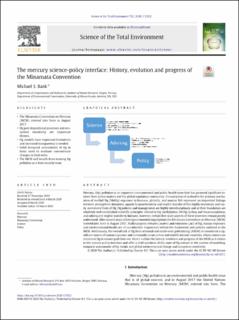| dc.description.abstract | Mercury (Hg) pollution is an important environmental and public health issue that has garnered significant interest from policy makers and the global regulatory community. Consumption of seafood is the primary mechanism of methyl Hg (MeHg) exposure in humans, globally, and marine fish represent an important linkage between atmospheric dynamics, aquatic biogeochemistry and trophic transfer of this highly neurotoxic and easily assimilated form of Hg. Hg policies and management are highly interdisciplinary and at their foundation are relatively well established scientific principles related to Hg methylation, MeHg cycling and bioaccumulation, and subsequent trophic transfer to humans; however, certain fine-scale aspects of these processes remain poorly understood. After several years of intergovernmental negotiations the Minamata Convention on Mercury (MCM) entered into force in August 2017. Anthropogenic releases (water) and emissions (air) of Hg, human exposure, and environmental health are of considerable importance within the framework and policies outlined in the MCM. Additionally, the overall risk of Hg from artisanal and small-scale gold mining (ASGM) is considered a significant source of human exposure and commonly occurs in low and middle income countries, where miners use elemental Hg to extract gold from ore. Here I outline the history, evolution and progress of the MCM as it relates to the science-policy interface and offer a brief synthesis of the state of Hg science in the context of modeling, temporal assessments of Hg trends and global environmental change and ecosystem sensitivity. | en_US |
